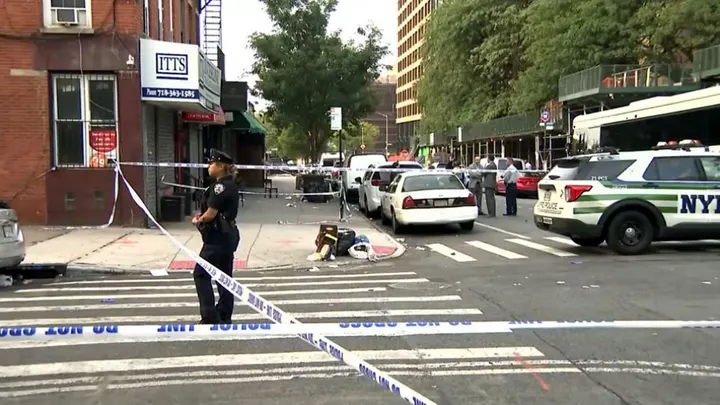Target parking-lot, Fort Stewart base… recent deadly shootings in US and why this won’t stop soon

NYPD officers respond to a deadly shooting at a Midtown Manhattan office building housing major firms including Blackstone and the NFL, July 28, 2025.
Over the past several weeks the U.S. has seen multiple deadly, high-profile shootings in public spaces, on a military base, and in an office setting — underscoring persistent gaps in prevention, enforcement, and policy. Key incidents covered below include: the Target parking-lot shooting in Austin, Texas (Aug 11, 2025); the Fort Stewart base shooting in Georgia (Aug 6, 2025); and the Midtown Manhattan workplace mass shooting (Jul 28, 2025). These are representative of broader summer trends that see spikes in firearm violence.
1) Target parking-lot shooting — Austin, Texas (Aug 11, 2025)
What happened: Police were called shortly after 2:15 p.m. local time to a Target store on Research Boulevard in north Austin after multiple shots were reported. Officers arriving within minutes found three people with gunshot wounds; two were dead at the scene and a third later died at a hospital. A fourth person was treated for injuries unrelated to gunfire. One of the deceased was a child.
Suspect & capture: Authorities say the suspect — a man with a documented mental-health history and prior criminal record — fled the scene, stole a vehicle from the parking lot, crashed it, then forced entry into another vehicle at a nearby dealership before being arrested in south Austin after police used a taser. Motive remains under investigation. Local officials confirmed the scene was held as an active crime scene and advised patrons that vehicles remained on site until cleared.
What to watch: Investigators will determine whether the suspect acted alone, whether weapons were legally possessed, and whether mental-health interventions could have prevented escalation. Target and city officials are cooperating with the probe.
READ ALSO
Austin Target shooting leaves three dead, including a child — who is behind it?
2) Fort Stewart base shooting — Hinesville, Georgia (Aug 6, 2025)
What happened: On Aug. 6, multiple U.S. Army soldiers were shot at Fort Stewart, a large Army installation in Georgia. Reports indicated at least five wounded. Authorities detained a suspect; the shooting renewed scrutiny of security and active-duty safety at military installations.
Context & response: Shootings on military bases are comparatively rare but especially alarming because they involve servicemembers and raise questions about base access, weapons screening, and mental-health support for military communities. The incident prompted immediate lockdown procedures and an internal military investigation.
Fort Stewart shooting: What happened, who is suspect Quornelius Radford?
3) Midtown Manhattan (Park Avenue) workplace mass shooting — New York City (Jul 28, 2025)
What happened: A shooter entered an office building on Park Avenue and opened fire, killing multiple people and injuring others. Preliminary reporting identified the suspect and noted that the shooter died of a self-inflicted wound; motive investigations referenced workplace grievances. The attack killed several people (reports list four victims plus the shooter) and wounded others; it was among the deadliest shootings in Manhattan in years.
Details & weapons: Coverage reported the alleged use of a semi-automatic rifle; investigators examined how the assailant acquired the weapon and any prior warning signs. The incident triggered intense local and national coverage about threats to workplace safety and building security in dense urban environments.
Six dead, including police Officer, in Midtown Manhattan office shooting
4) Multiple summer shootings & city-level incidents (contextual examples)
-
Chicago: Over recent weekends Chicago experienced multiple shootings at large gatherings and parties, leaving several dead and many wounded; local reporting highlights recurring violence concentrated in certain neighborhoods.
-
Holiday spikes: Analysts and researchers note that firearm violence often rises in summer months and around holidays like July 4 — a pattern borne out in 2025 data and reporting.
Data & trends — how frequent and severe is this wave?
-
Mass-shooting trackers & databases: Organizations that track mass shootings and gun violence — including the Gun Violence Archive and crowdsourced trackers — show hundreds of mass-shooting incidents nationwide so far in 2025, with hundreds of fatalities and injuries. These datasets are updated regularly and show seasonal increases in the summer months.
-
Summer pattern: Public-safety researchers and news analyses repeatedly note that warmer weather, large outdoor gatherings, and holidays correlate with higher rates of shootings. The July–August period historically shows spikes in gun incidents across many U.S. cities.
Root causes & contributing factors (what the incidents collectively reveal)
-
Access to firearms — Many high-profile shootings involve firearms (including semi-automatic weapons) that enable rapid, mass harm. Investigators routinely examine how perpetrators obtained firearms (legal purchases, transfers, theft). Policy debates focus on background checks, red-flag laws, safe storage, and restrictions on certain weapon types.
-
Mental health and warning signs — Authorities frequently cite a suspect’s mental-health history in these cases (as in the Austin shooting). Experts caution that mental-health issues alone are not predictive of violence, but lack of access to care and gaps in crisis intervention can be contributing factors.
-
Security & public-space vulnerability — Public venues (shopping centers, parking lots), workplaces, and even military bases can be vulnerable if security measures or risk-mitigation procedures are insufficient. Urban density, open access, and varied jurisdictional responsibility complicate prevention.
-
Social and seasonal dynamics — Summer months, holiday gatherings, and large public events raise the chances of conflicts and group violence, contributing to higher incident counts.
-
Criminal histories & recidivism — Several suspects in recent incidents had prior criminal records; gaps exist in preventing re-offenders or in integrating criminal-justice supervision with safety planning.
National implications — short and long term
Public safety & community trust
Repeated shootings, especially in everyday public spaces, lower citizens’ sense of safety and heighten anxiety about routine activities (going to a store, work, or a gathering). Local governments must balance open access with protective measures, which can be costly and contentious.
Policy and politics
High-profile incidents spur renewed calls on both sides of the aisle: for stricter gun regulations (expanded background checks, safe-storage laws, assault-weapon restrictions) and for improved mental-health services and enforcement of existing laws. However, legislative action faces significant political gridlock at the federal level, leading to a patchwork of state-level responses. The 2025 incidents are likely to re-ignite this national debate.
Law enforcement & trauma care
Police, emergency responders, and hospitals face recurring trauma from frequent mass-casualty events. There are calls for more investment in active-shooter training, trauma-care capacity, and post-incident support for first responders and communities.
Economy and civil life
Businesses and institutions (retailers, universities, employers) may invest more in security and insurance, raising operational costs. Tourism and urban business districts may experience short-term downturns after high-profile events.
Legal and constitutional debate
Incidents like the Midtown workplace shooting revive debates over which restrictions on firearms are consistent with the Second Amendment, while other cases pushing links to mental-health history or criminal records raise questions about privacy and civil liberties. Judicial decisions and state laws will continue to shape what measures are possible.
What policymakers, cities and communities are doing (and could do)
-
Short term: increase patrols in high-risk areas, fund outreach and cooling-off programs around large events, improve emergency-communication plans, and accelerate forensic and investigative resources.
-
Medium term: strengthen community violence intervention programs (CVI), expand crisis-response teams that pair clinicians with responders, and target illegal gun markets.
-
Long term: consider legislation on background checks, safe storage incentives, red-flag laws with due process, and greater mental-health and social-services funding — combined with evaluation frameworks to measure what reduces homicides and mass-shooting occurrences. Several cities and states have piloted combinations of these strategies with mixed but promising results.




